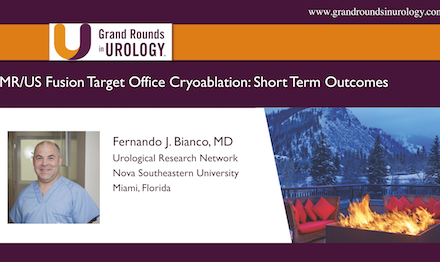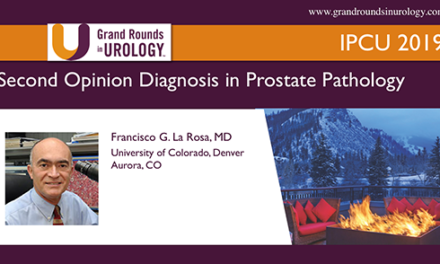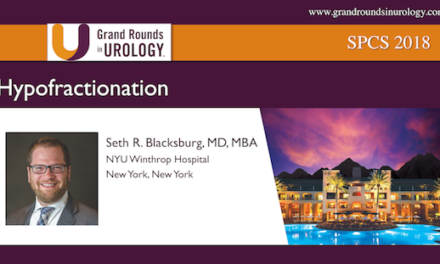Dr. Brian J. Moran spoke at the 16th Future Directions in Urology Symposium on Monday, August 10, 2015 on “Focal Therapy for the treatment of Prostate Cancer”
Presentation
Keywords: focal therapy, prostate cancer, spectrum, cryotherapy, High Intensity Focused Ultrasound (HIFU), vascular photodynamic therapy (PDT), focal laser ablation (FLA), brachytherapy
How to cite: Moran, Brian J. “Focal Therapy” Grand Rounds in Urology. September 4, 2015. Accessed Nov 2024 https://dev.grandroundsinurology.com/focal-therapy-treatment-prostate-cancer.
Transcript
Focal Therapy
We’re going to talk about focal therapy and focal therapy is really the product of patient desire. Whether we believe in it or not its here. Hashim Ahmed and Mark Emberton in the U.K. have done some really novel work and as I talk about it.
We’ve also talked about this concept of the spectrum. We heard one size doesn’t fit all. I think with all the increased technology with genomics and molecular markers technology is taking us on a different therapeutic course or approach to patients and you really have to look beyond the scope of low, intermediate, high risk. You have to consider volume. I’m very pleased to be at meetings today and see other speakers speak of the spectrum and also recognize the patients overall health spectrum. Their age, their comorbidities, it’s not uncommon for us to see in the clinic an 80-year-old executive who’s potent, walks the golf course, shoots his age and he doesn’t want toxicity.
Why do focal therapy? Obviously it makes sense for the right patient with low volume, low risk disease. He is in a compromise between active surveillance versus radical homeland therapy. Can it achieve equal disease eradication? That’s where technology is going to help us. It’s going to help us identify this subset of patients. That’s what we’re struggling, all the focal therapists today, is to really define who’s a good candidate for it. Obviously the one thing in its favor it has numerous salvage options. Patients are asking for it.
If you were to look at today’s focal therapist, I know I’ve shown this slide, but I can’t emphasize it enough because under-treatment, over-treatment it’s a balancing act and where the difference associations stand on it it’s going to be slow to be accepted in the U.S. but it’s taking over in Europe. Much of the new data is going to be coming out of Europe. Is there a precedent? Mike Brawer stole this slide from ten years ago. This is partial breast radiation and my colleagues in our society frowned on it five years ago. It’s accepted standard of care today. It’s here to stay. This textbook just came out if you don’t have it I’d encourage you to—it’s very well written. It’s a nice little easy to read text. Hashim put it together with Peter Carroll and Mark Emberton and Manit, who I don’t know, but I read it page to page and I think it’s a very easy read and it will really make you think about something.
In Vail this year Mark Emberton came out and said brace yourself for the revolution. The revolution is going to be of not knowing where the tumor to knowing where the tumor is. In urologic circles there’s just MRI, whether you do a transrectal or transperineal or fusion MRI is going to have a big role in this. The question is and I’ll touch on it briefly when I get to the MRI slides, but instead I’ll just keep going with this.
This is the patient’s point. Cure rates, obviously, bladder/bowel toxicity, sexual function, time off work. Time of work, this recession’s real. A lot of our patients come into clinic and they’re like doc I can’t be out; I have to work. Obviously cost is really going to have an impact on where we go especially with the new technology.
Like Dave said, I think we really have to streamline algorithms that are not only integrating all of our new technology but doing it in a costly manner. In Chicago it’s taken off on this value concept that I’m not going to really talk about.
This slide I am going to spend some time on and this is out of the textbook and it’s really brilliant what they did. We got LAT, HAT, and SAT and this is the way the focal therapists are starting to think. If you look at the LAT lesion is lesion ablation therapy. That’s all you’re going after and as these biopsy techniques become more sophisticated the clinician’s confidence is going to rise significantly. I am really excited about it. There are probably five different approaches but there’s going to be a winner as to what’s the best way to identify the dominant index lesions.
Hemi ablative therapy, that’s where we are right now, we’re doing a lot of hemis. Then obviously you can see the dominant lesions here and there’s quite a bit of literature that they speak of in the textbook about what’s significant. Maybe you don’t need to treat these. That’s what we’re learning right now. Those three bars are self-explanatory on the bottom. Obviously the likelihood of cure the less aggressive you are. You might not be as likely to cure them however the number of candidates it just explains itself. I don’t want to spend too much time on that.
The bottom line obviously is the effect on mortality. I would venture to say that much of the data out there on survival data I don’t think it’s going to have a negative impact. It’s going to be every bit survival-wise, we all know that especially in these patients we view prostate cancer as chronic disease.
These are the current modalities. Gary Onik, as Dave said is really the pioneering work that I’ll show you his data, it’s the best data that’s out there. HIFU really we don’t have much. PDT Scott Eggner in Chicago just finished his protocol. We’re excited to see his results. Then focal laser ablation. Then obviously brachytherapy, which there’s a few of us in the country offering it non-protocol.
Who are candidates? This is a big debate. Is it the low risk, low volume? Everybody would agree on that. What about intermediate risk low volume disease, high-risk low volume disease. In an elderly man toxicity is an issue. Every bit a candidate in my mind. Gary’s data that I’m showing you here right now is great data. He did it with cryo. He really was doing this way before many of us were doing anything. You can see that the low intermediate and high-risk patients they all did relatively well. He did use the Phoenix definition. I give him a lot of credit for that. He was ahead of his time on that.
This is the interesting thing. Doing focal therapy recurrent patterns there’s definitely value in a mapping whether you use MRI or not. The traditional extended sextant biopsy is not as accurate. It grossly underestimates disease; toxicity profile is very favorable for Gary’s male lumpectomy.
Our experience how these patients got to us for one reason or another we treated them with focal therapy and 46 of them were done with the transrectal biopsy for which we’re analyzing the recurrence data. It’s really minimal; we haven’t really seen any. What is important is the first five years experience look at the median age. These were healthy men; otherwise we never would have considered them. The last five years it’s dropped and it’s dropping precipitously. We’re having men in their fifties and sixties as us for focal therapy. They’re being put on protocol.
This is the breakdown of the risk groups that we’re treating. You can see that they’re not all low risk low volume disease. There’s a significant portion of intermediate risk patients and they’ve done well. This is the big question; PSA response. You have to think logically about it. If you treat half the prostate you still have 50% remaining prostate that’s PSA productive. This is a big debate at most of the discussions I’ve been involved with. I think that right now the Phoenix definition is still a good one to go by. That’s nadir plus two.
This is new concept definition. We call it the impact PSA kinetics. Regardless of the modality of focal therapy that’s used it’s a logical approach as to the percentage of the gland that’s treated should have at least some percentage impact on the initial PSA. We’re analyzing this data right now and we don’t have that data.
The key identifier, what area to treat, the dominant index lesion. MRI is doing that well in tumors over 0.5 centimeters. MRI is not of much value in tumors less than that. In fact, I just reviewed a paper that’s going to be out in Urologic Oncology. It’s a really great study out of Paris where they did MR transperineal mapping biopsies 380 patients and in the patients the that MRI were negative they then went back and did a comprehensive mapping biopsy and they found cancer in 40% of those patients, 70% of which met NCCN clinically significant disease.
I think it’s going to be a combination of both. I’m not willing to just throw out comprehensive 3D mapping biopsies.
This is an example just of a dominant index lesion and we’re seeing more and more of it. The debate I think is going to be coming between multiparametric and then the comprehensive 3D mapping. I think the winner is going to be a hybrid of those two technologies. I think they both will benefit each other. Prior to this we only had radical, we all know the radical data, the upstaging, and it’s significant. It shouldn’t be ignored especially with today’s diagnostic tools we have available.
This was just published in my society journal and it’s exciting for me to see that the radiation oncology community is finally starting to get on board and consider this. This was just published last month.
This is Dave’s data. I have very similar data. The bottom line is they do a 5-millimeter XYZ; we call it stereotactic because it is stereotactic, but I’m fine with 3D prostate mapping biopsy. I think that’s the term most commonly used in the literature. It’s very sensitive. It really doesn’t miss.
The last bullet point they look at that whole mount radicals and it had a 96% concordance value. We found the same thing in Chicago in 107 patients. It was 96, 97%. It is value.
This is where things are going, just speaking with a few people, some of the new software companies are coming out and its I think, for all practical purposes address MRI, ultrasound, fusion technology. Again, symbiotic relationship between the different diagnostic tools. This is where the tumor was identified on a MRI and on mapping biopsy and then this is the implant needle going into target that area. That software is very exciting. We can’t afford it. We’re working with a company that’s letting us use it.
This is my new study we just opened in April and you can see that the accrual rate is very fast and so I have no problem as long as patients go on study in informed consent we’re going to probably finish this before the years out.
Our goal here is to really document that you really shouldn’t even consider focal therapy based on transrectal biopsy. We did include those patients and that’s just going to be a big question that we can all get out there and move focal therapy forward. We are using cesium on these patients based on its energy in the physics world. It has the most generous energy and my philosophy there was if I’m skimping on things then I definitely want to use a generous energy to avoid cold spots. I think a brachytherapy definitely will have a role in focal therapy.
We don’t know optimal outcome. Follow-up is a problem especially with regard to the PSA and it’s not the nadir so much as the PSA kinetics post-therapy. I think everybody’s agreeing on that.
It is fun. We have a lot of people working on this around the world and listening to them put their heads together is exciting. This is exciting because it goes back to 2008 was the first international focal meeting and it’s happening.
I would say there’s emerging evidence focal therapy will have similar disease control as whole gland treatments however the morbidity may be much less. In my experience without question it is. A partial implant versus a whole gland brachytherapy there’s no comparison. I think it does have significant promise. I think that proper patient selection ideally treated on study, optimal modality I think there will be a few of them and salvage treatment.
We were at the meeting in Vail and the question was posed to a very impressive panel of urologic surgeons. Jim was up there, Alan and the question was posed to these guys; do you think there’s a role for focal therapy. Across the board there was not one person that said no. I was blown away by that. When I saw the caliber of those individuals say yes, in select patients there probably is a role.
ABOUT THE AUTHOR
Brian J. Moran, MD, is Medical Director of Chicago Prostate Cancer Center, which he helped found in 1997. He is also the Director of Radiation Oncology at DuPage Medical Group. He has been performing prostate seed implants since 1994. Dr. Moran is a graduate of Loyola Stritch School of Medicine, where he also completed his residency. He is board-certified by the American Board of Radiology. An experienced practitioner of prostate brachytherapy, Dr. Moran has performed thousands of prostate seed implants and has proctored physicians all over the United States and the world, including in Korea, Europe, and Hong Kong. Dr. Moran is a member of multiple specialty societies, including the American Society of Therapeutic Radiology and Oncology, the American College of Radiology, and the American Brachytherapy Society. His emphasis is on quality of life issues and long-term outcomes for prostate cancer patients. Dr. Moran is a frequent speaker at professional meetings, and has authored numerous publications in medical journals and textbooks.





